This crimson red cabbage sauerkraut recipe is easy to make, with minimal ingredients and a little patience. Crunchy, tangy and gut friendly – this fermented red cabbage recipe is a real winner.
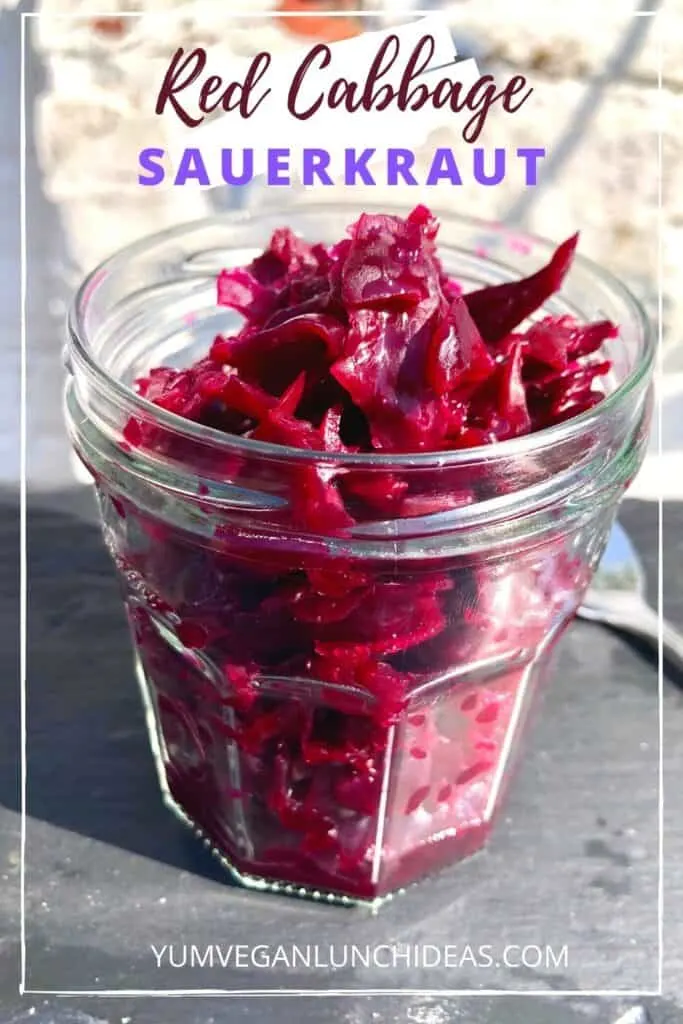
This particular kraut recipe is my staple, as I absolutely love the vibrancy and taste of red cabbage. It adds so much depth, flavour and goodness to so many dishes for me.
I always have a batch of this readymade in my fridge as it is my absolute favourite! There really is something special about the bright red cabbage kraut.
- Earthy
- Crunchy
- Tangy
- Wholesome
What is Red Cabbage Sauerkraut?
Red cabbage kraut is essentially fermented cabbage, using a simple but ancient technique of fermentation. This method of preserving perishable foods dates back to the fourth century BC.
This is a super popular food in Germany and Eastern Europe, clearly revered worldwide now for its deliciousness and health benefits.
Health Benefits of Sauerkraut
Probiotic
During the fermentation process, live bacteria is produced which gives the sauerkraut its health benefits.
Fermented foods are renowned for having probiotic benefits. This means they increase the healthy gut bacteria and allow your guts ecosystem to flourish.
This healthy bacteria is thought to feed the good bacteria already in your gut and can overall reduce inflammation in the body.
Gut health is becoming increasingly popularised, with many probiotic products on the market coming with a price tag.
Improving your gut flora can contribute to a healthy immune system. That’s why it’s great to include fermented foods such as the red sauerkraut recipe in your daily meals.
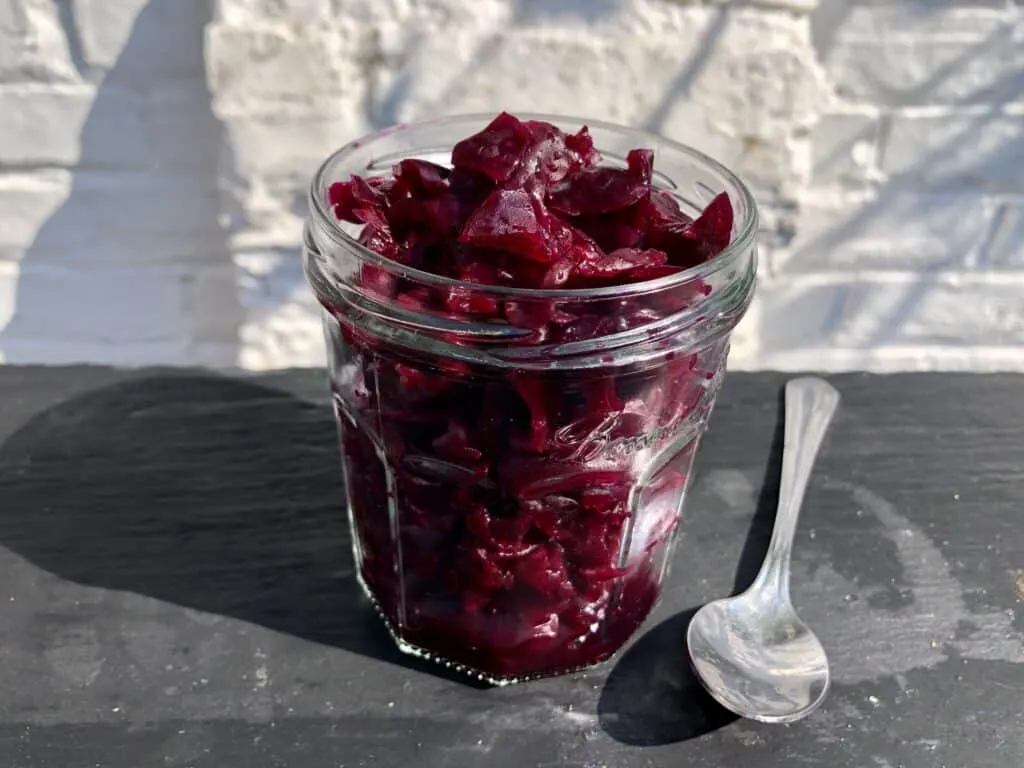
Nutrients
Red cabbage contains good levels of Vitamin K, C, calcium, potassium and phosphorus.
In fact red cabbage has around seven times more Vitamin C than its green cabbage counterpart. Additionally it has much more iron and Vitamin A concentration than green cabbage.
Anthocyanin polyphenols are what gives red cabbage its beautiful deep, rich colour, which boost anti-inflammatory and antioxidant purposes of this delciious plant food.
Fibre
Of course this provides a great source of fibre – which in turn increases its gut-friendliness!
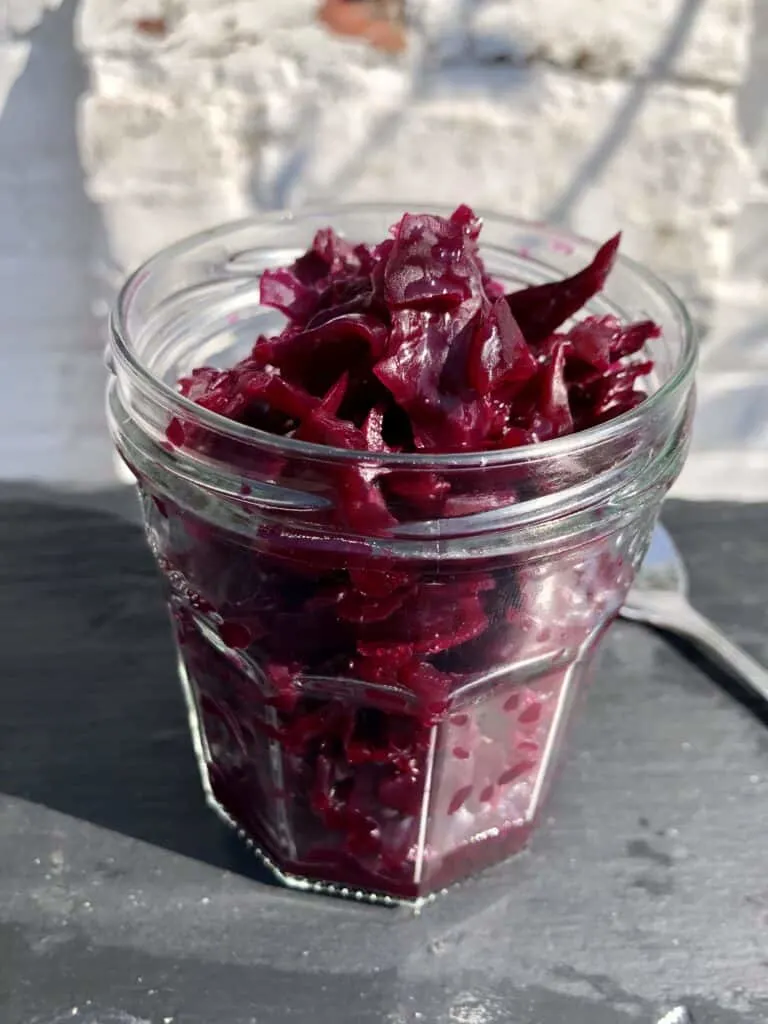
Homemade Red Sauerkraut Recipe
Making sauerkraut at home is super easy, when a few simple steps are followed. Not only is it easy to make, it will also save you a bunch of money.
Although many stores sell what appears to be fermented foods on the shelf these are usually loaded with vinegars to give the fermented appeal.
This sauerkraut recipe is easy to make, tasty and cost friendly – with the aded bonus of health benefits.
Eat The Rainbow
Many of us have heard the term “eat the rainbow”. One of the exact reasons for this is because including a variety of colourful fruits and vegetables means we optimise our nutrionial intake.
In addition to this, including variety plant based foods in our diet is also known to improve gut health. So this vibrant homemade sauerkraut recipe is most certainly included.
Two Ingredient Sauerkraut
This delicious a crunchy sauerkraut recipe is literally just two ingredients!
- Red Cabbage
- Salt
What You Will Need
The following equipment will be necessary to make this red cabbage kraut recipe.
- Mixing Bowl
- Chopping Knife
- Food Processor
or Grater
- Sterilised Mason Jars
- Sterile Gloves (optional)
You can also get hold of helpful Fermentation Kits.
How to Sterilise Jar
It is important to use a sterilised jar to ferment the cabbage in. This is because the cabbage will be fermenting there for a number of days or more (depending on how tangy you want it).
If the jar is not sterilised sufficiently the kraut may go bad. Choosing the right jar also helps – these Mason jars work perfectly for fermenting as this is exactly what they have been designed for!
Simply sanitise the jar or jars just before you plan to make the fermented red cabbage. Pop the jars in a large pan with boiling water, cover – and ensuring the boiling water is inside the jar.
Leave on a rolling low boil for up to five minutes (do not boil lids as this may spoil them). The lids may be dipped briefly into the boiling water at the end. Remove very carefully using and leave to air dry on the counter top.
If the jars are too large for a pan – simply place standing up in a clean sink and pour boiling water into the jar – leave stand for five minutes and then empty to air dry.
What To Eat With Sauerkraut?
Sauerkraut is a great addition to a number of foods! I like a spoonful out of the jar here and there.
Heres what else you can do with it:
- Sandwiches
- Salads
- Burgers
- Buddha Bowls
- As a side dish
- On top of avo toast
- As a soup topper
- As a salsa
- On a stir fry
- Jacket Potato
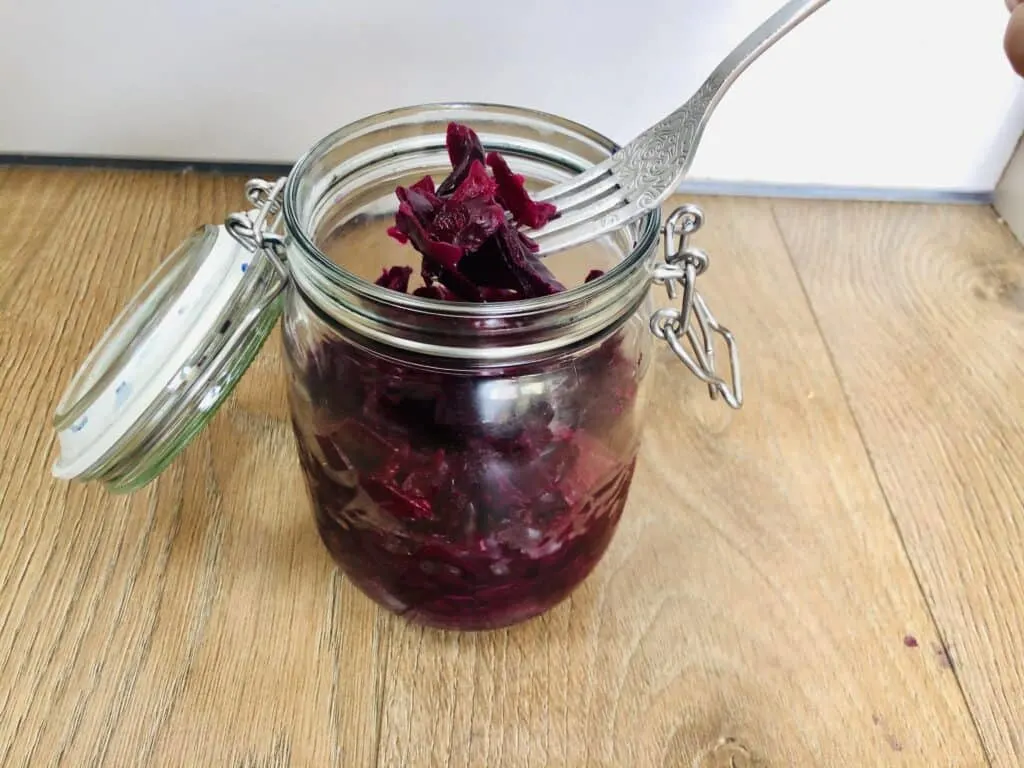
Red Cabbage Sauerkraut Recipe
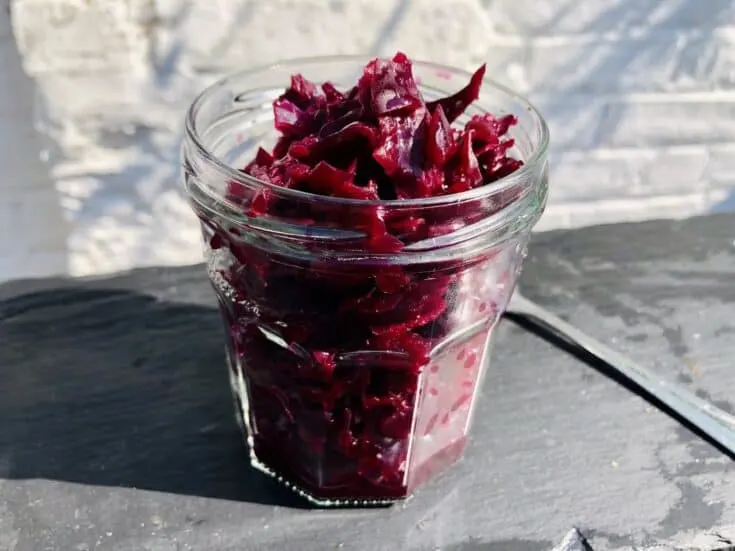
This crimson red cabbage sauerkraut recipe is easy to make, with minimal ingredients and a little patience. Crunchy, tangy and gut friendly – this fermented red cabbage recipe is a real winner. It is the perfect probiotic for optimal gut health.
Ingredients
- 800g red cabbage
- 2 tbsp salt
Instructions
- Sterilise storage jars
- Remove outer layers of cabbage and discard of any bad bits. Keep one big leaf to one side, as this will be used as a weight to hold the shredded cabbage down.
- Begin shredding your red cabbage. Some people prefer to use a knife, others like to grate it finely. A food processor definitely saves some elbow grease! If you prefer a fine sauerkraut a grater or food processor would work great.
- Place shredded cabbage in a large bowl. Sprinkle salt onto the cabbage, and of you dont want to stain your hands, use some sterile gloves to massage the red cabbage and salt together. You will begin to see the red cabbage "sweat".
- Keep massage the cabbage and squeezing the juice from it. This may take 5-10 minutes so be prepared for some satisfying handy work!
- Place handfuls of the cabbage in your sterlised jar, one handful at a time and use a pushed to press it down into the jar to release more juices.
- Once all cabbage has been pressed down, then top with the remaining liquid from the bowl.
- Place the large cabbage leaf on top - this will keep the red cabbage below the liquid, which is neccesary for a succesful ferment.
- Place the lid securely on top - and it is ready for fermenting!
- Place the jar in a cool, dark place for a number of days, Every couple of days pop the lid to allow the air bubbles out and ensure the cabbage is below the liquid.
- The longer you leave the red cabbage in this dark place, the tangier or more "sour" the kraut will be.
- When you are satisfied with the flavour having taste tested it - simply place in the fridge and enjoy!
Notes
1) The thicker you shred the cabbage, the more massaging will be needed!
2) No need to clean the cabbage prior to use as the fermentation relies in the natural bacteria on the cabbage, For this reason, organic cabbage is often better as it has not been sprayed with articial chemicals.
Nutrition Information:
Yield:
12Serving Size:
1Amount Per Serving: Calories: 19Total Fat: 0gSaturated Fat: 0gTrans Fat: 0gUnsaturated Fat: 0gCholesterol: 0mgSodium: 2344mgCarbohydrates: 5gFiber: 2gSugar: 2gProtein: 1g
this is an estimate

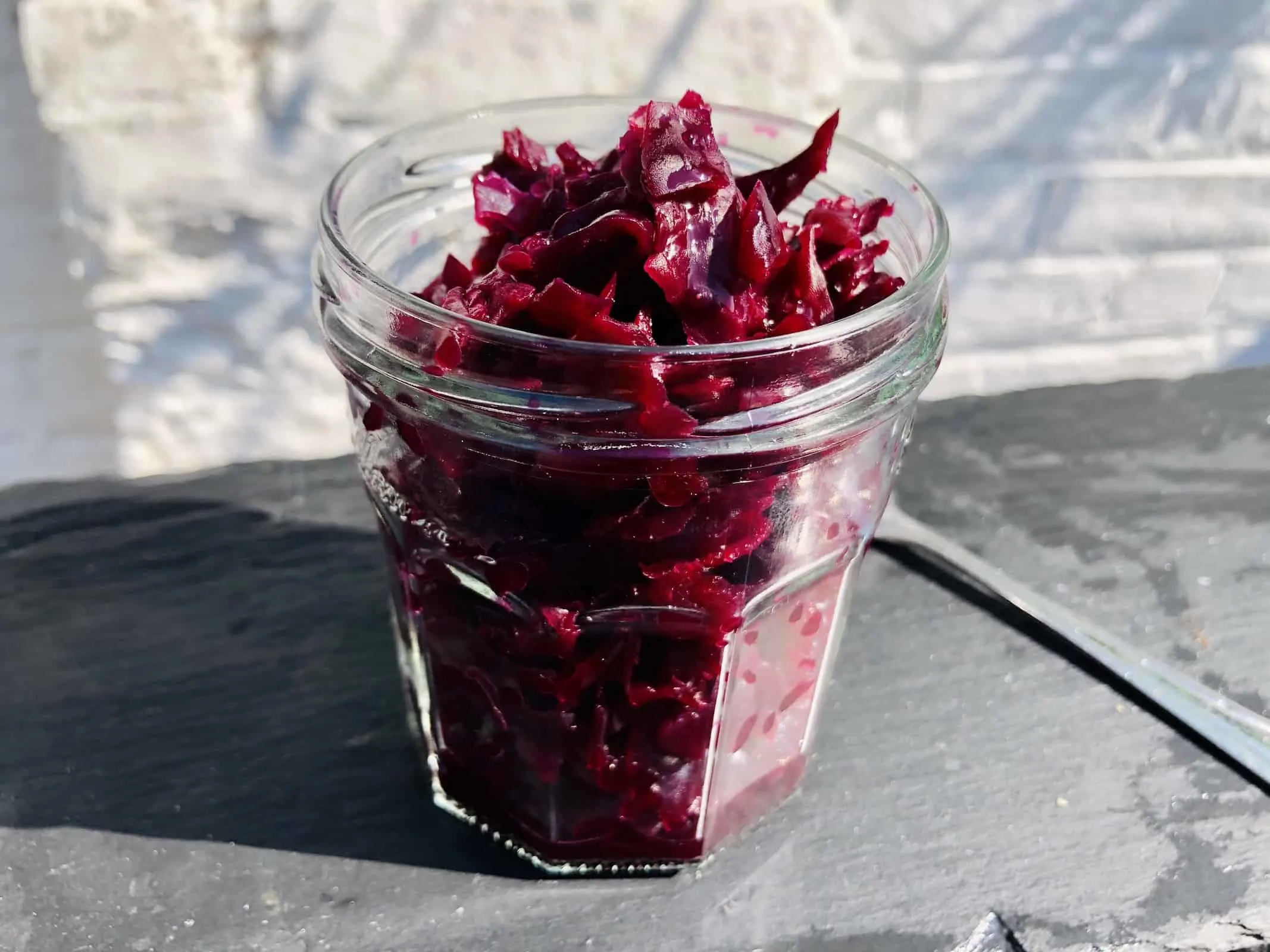
Pamela Bartram
Monday 6th of June 2022
Can you leave this in the fridge to ferment or does the jar need to be out till fermented?
yumveganlunchideas
Tuesday 21st of June 2022
Hi Pamela, it will need a warmer temperature than a fridge to ferment. The process will slow down significantly or stop if placed in the fridge. However once you are happy with the level of fermentation on the cabbage consistency - the longer you leave it the softer it should become, or if you like it with a bit of a bite still you can place it in the fridge sooner. This will then help it stay fresh. Hope this helps, thanks, Gill
Cheryel
Friday 11th of March 2022
I have arthritis in my hands, and it would hurt to knead the cabbage. Could I use a stainless steel potato masher?
Kate
Sunday 3rd of July 2022
@yumveganlunchideas, Sauerkraut crocks are often sold with a wooden tamper. So I just use a wooden spoon and bash it about until the juice starts flowing.
It’s best not to use metal, as it can taint the flavour of the kraut.
yumveganlunchideas
Monday 28th of March 2022
Hello Cheryel,
I will be honest and say it is a bit of a hand work out, and the idea is to properly squeeze the juice out tightly. I would hate to tell you to use a potato masher and it not work out for you. Could you rope a friend in to help? :) Best wishes Gill
JJ
Wednesday 8th of September 2021
Seems like a lot of salt. Most sauerkraut recipes call for 2% salt which in this case would be 16g, more like 1 tblsp, if one has a scale to weigh the cabbage, one should be able to use the same scale to weigh the salt? Perhaps a bit more precise.
yumveganlunchideas
Monday 27th of September 2021
Hello JJ - this is a great point! I do like my sauerkraut on the salty side and the reason I added slightly more is because the cabbage in my recipe was thicker cut than the usual finer shredded type. I guess you could add as much or little salt as you like depending on your tastes, so long as you are getting sufficient brine from the cabbage. Thank you for your tip however! Best wishes, Gill
Jenn
Friday 6th of August 2021
Just finished and followed the directions exactly. Quick question! Won't the large leaf that is used to weigh down the cabbage start to mold and contaminate the rest?
yumveganlunchideas
Monday 9th of August 2021
Hey Jenn - thank you for trying the recipe! So the cabbage leaf weight is a centuries old method apparently - although I've never experienced mould, if you pick the right size leaf and not too big - it too can be submerged under the brine. I do find it can float back up in the jar at time in which I just press it down again with a sterilised utensil whenever I am letting the bubbles release. Hope this works for you! If you are not confident - there are also certain kraut weights you can purchase :) Best wishes, Gill
Mark Hoffman
Tuesday 6th of April 2021
Why sterilize (or more properly, sanitize) the jars when the cabbage doesn't even need to be rinsed?
Gillian Edwards
Monday 12th of April 2021
Hi Mark, it is thought to be best to have a sterile jar as the food stuff will be fermenting in there for a matter of time and then stored for a number of weeks. We are removing and discarding the outer most layers of the cabbage, which should be enough. Usually there is enough lactobacillus (good bacteria) to over ride any bad bacteria left on the cabbage. If you are concerned about germs and pesticides, you can certainly wash your produce first. I hope this helps. Best wishes, Gill